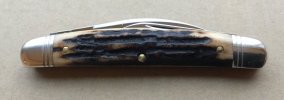Forward: re-reading this post it seems a little preachy, but I hope it comes across as one guy's close look at factory grinds (with respect to suitability for wood carving, in particular). I used a color filter to make the bevels more prominent.
As promised: the left side has two seahorse whittlers - the right side you'll see two PCs.
The knives to the back haven't been sharpened yet, and the two in the front I took to a stone.
Note the egregious sins of the upper left seahorse whittler. You can see how the blade starts at the choil more prominent than other areas, then recedes, then displays a prominent belly towards the nail nick before diving off again at the tip. You end up sharpening off those prominent places before you can even touch the low spots. I'm not even going to mention the left to right apex wandering (hard to photograph), but it's always there. The PC even has a "dive off" at the very tip if you look closely enough.
GEC does a much (MUCH!) better job than Case, but any knife taken to a grinding wheel by hand (without a jig of some kind) is always going to have these traits to some degree. You'll notice how "short" the bevel looks on the factory GEC grind. Shortness indicates steepness of bevel angle in blades of similar geometry. You'll note that the one I sharpened has a longer bevel, and that's what I'd consider general purpose. For specific whittling I might thin it out even more, like
 Jiki
Jiki
might do. the Case looks like a really thin bevel, but it's a trick of the thickness of the blade and the slope of the primary grind.
Anyway- this is just something I've been thinking about since you brought up "stropping only" sharpening methods,
 hornetguy
hornetguy
.
I just can't figure out how stropping would solve these issues in the short term. Over long enough time I could imagine stropping would take care of them- but then again with enough time the grand canyon was carved out, haha.








